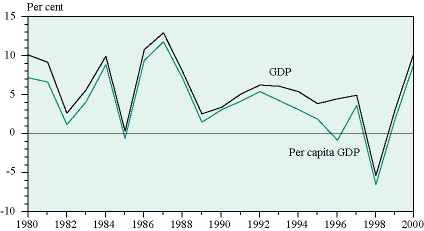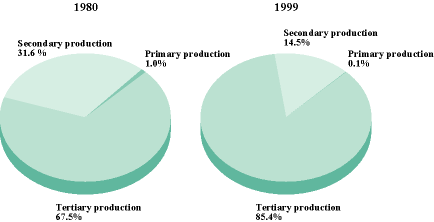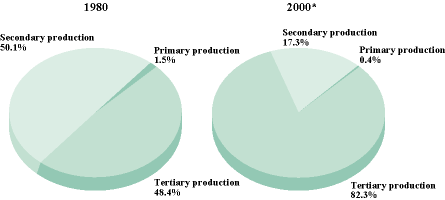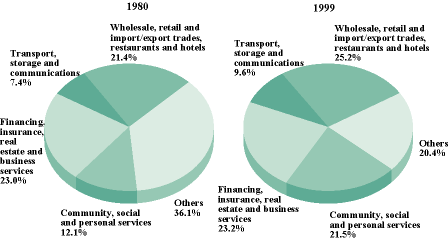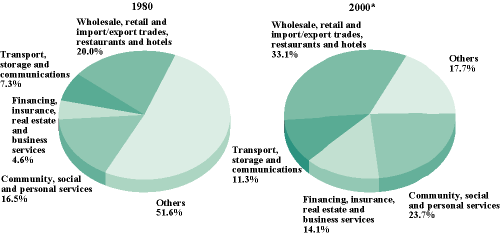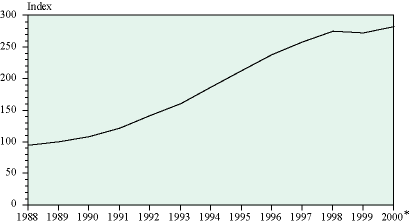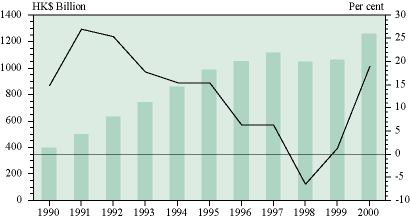Structure and Development of the Economy
Backed by its strategic location at the doorway to the Mainland and on the international time zone that bridges the time gap between Asia and Europe, the Hong Kong Special Administrative Region (HKSAR) has been serving as a global centre for trade, finance, business and communications. Hong Kong is now ranked the 10th largest trading entity in the world. It operates the busiest container port in the world in terms of throughput, and also one of the busiest airports in terms of both the number of passengers and volume of international cargoes handled. At the same time, it is the world's 10th largest banking centre in terms of external banking transactions, and the seventh largest foreign exchange market in terms of turnover. Its stock market is the second largest in Asia in terms of market capitalisation.
Hong Kong is characterised by its high degree of internationalisation, business-friendly environment, rule of law, free trade and free flow of information, open and fair competition, well-established and comprehensive financial network, superb network of transport and communications infrastructure, sophisticated support services, and a well-educated workforce complemented by a pool of efficient and enterprising entrepreneurs. Added to these are the substantial amount of fiscal reserves and foreign exchange reserves, a fully convertible and stable currency, and a simple tax system with low tax rate. On these virtues, Hong Kong is widely regarded as amongst the freest and most competitive economies in the world. The US Heritage Foundation ranks Hong Kong as the world's freest economy for the seventh year in a row in 2000. The Cato Institute in the United States, in conjunction with 53 independent research institutes in other countries, also ranks Hong Kong as the freest economy world-wide. The World Economic Forum rates Hong Kong as the second most competitive economy in Asia and the eighth in the world.
Over the past two decades, the Hong
Kong economy has almost tripled in size, with GDP growing at an average
annual rate of 5.4 per cent in real terms. This outperformed the growth
of the world economy as well as that of the Organisation for Economic
Co-operation and Development (OECD) economies. Per capita GDP in Hong
Kong has more than doubled in real terms, equivalent to an average annual
growth rate of 3.9 per cent in real terms. In 2000, it reached US$24,000
at current market prices, which was amongst the highest in Asia, next
only to Japan.
| Chart 1 |
|
Reflecting the increased external orientation of the economy, trade in goods and trade in services grew substantially, by eight times and three times respectively over the past two decades. In 2000, the value of visible trade (comprising re-exports, domestic exports and imports of goods) amounted to $3,234 billion, corresponding to 254 per cent of GDP. This was considerably higher than the ratios of 148 per cent in 1980 and 221 per cent in 1990. If the value of exports and imports of services was also taken into account, the ratio was even higher, at 295 per cent in 2000, as against 181 per cent in 1980 and 260 per cent in 1990.
The Gross National Product (GNP), comprising GDP and net external factor income flows, stood at $1,293 billion in 2000. This was 1.7 per cent higher than GDP in the same year. Reflecting the highly externally oriented nature of the Hong Kong economy, both inflows and outflows of external factor income remained very substantial at $411 billion and $390 billion respectively in 2000, equivalent to 32 per cent and 31 per cent of GDP.
Contributions of the Various Economic Sectors
The relative importance of various economic sectors can be assessed in terms of their value-added contributions to GDP and total employment. By both measures, primary production (including agriculture, fisheries, mining and quarrying) is very insignificant in Hong Kong where natural resources are virtually absent.
Secondary production (comprising manufacturing, construction, and supply of electricity, gas and water), which once was a significant contributor to GDP, has dwindled in relative importance over the past two decades. To a large extent, this was attributable to the marked decrease in value-added contribution of the manufacturing sector, from 24 per cent in 1980 to 18 per cent in 1990, and further to only 6 per cent in 1999, consequential to the ongoing relocation of the more labour-intensive production processes to the Mainland. Also relevant was the rapid expansion in service activities, especially those related to the re-export and transhipment trades. As to the construction sector, its contribution to GDP likewise shrank, from 7 per cent in 1980 to 5 per cent in 1990, although it rebounded more recently to 6 per cent in 1999. By comparison, the share for the supply of electricity, gas and water held largely steady during the period, at about 3 per cent.
The open door policy and economic reforms in the Mainland have not only provided an enormous production hinterland and market outlet for Hong Kong's manufacturers, but have also generated abundant business opportunities for a wide range of its service activities. These activities include in particular freight transport, storage, telecommunications, banking, real estate development, and professional services such as legal, insurance and accounting. As a consequence, the Hong Kong economy has become increasingly service-oriented since the mid-1980s.
Reflecting this, the share of the tertiary services sector (comprising the wholesale, retail and import/export trades, restaurants and hotels; transport, storage and communications; financing, insurance, real estate and business services; community, social and personal services; and ownership of premises) in GDP rose appreciably, from 67 per cent in 1980 to 74 per cent in 1990, and further to 85 per cent in 1999.
| Chart 2 |
|
The structural transformation in the economy was also shown up in the variation in sectoral composition of employment. The share of the services sector in total employment leaped from 48 per cent in 1980 to 63 per cent in 1990, and further to about 82 per cent in 2000. On the other hand, the share of the manufacturing sector in total employment contracted noticeably, from 42 per cent in 1980 to 28 per cent in 1990, and further to only about 7 per cent in 2000.
| Chart 3 |
|
The Services Sector
The services sector has not only flourished but also diversified in types of activities, along with the structural change in the economy. Amongst the various service industries, community, social and personal services, and finance and business services have registered particularly rapid growth over the past two decades. In the more recent years, an accelerated growth was also observed in telecommunications services, especially those related to e-commerce and Internet applications, in line with the further restructuring of the economy more towards knowledge-based and higher value-added activities.
Between 1990 and 2000, both exports of services and imports of services exhibited strong growth, by an annual average of 6 per cent and 5 per cent respectively in real terms. Within exports of services, transportation had the largest share of 34 per cent, followed by offshore trading and purchasing/merchandising services (33 per cent), travel and tourism (18 per cent), and financial and banking services (6 per cent). On imports of services, travel and tourism were the most important, accounting for 56 per cent in 1999. Transportation services ranked second (with a share of 19 per cent), followed by offshore trading and purchasing/merchandising services (8 per cent), and financial and banking services (5 per cent).
Comparing 1999 with 1989, the net output or value-added of the services sector grew markedly, by an annual average of 10 per cent in value terms. Amongst the major constituent sectors, community, social and personal services had the fastest growth in net output (averaging at 13 per cent per annum). This was followed by financing, insurance, real estate and business services (11 per cent), transport, storage and communications (9 per cent), and the wholesale, retail and import/export trades, restaurants and hotels (9 per cent).
Ranked in terms of size of value-added contribution to GDP, the wholesale, retail and import/export trades, restaurants and hotels were the most important contributor in 1999, accounting for 25 per cent of the total. This was greatly aided by the robust performance of external trade and inbound tourism in that year. Financing, insurance, real estate and business services slipped back to the second place, with a share of 23 per cent. Community, social and personal services, and transport, storage and communications remained in the third and fourth places, with respective shares of 22 per cent and 10 per cent.
| Chart 4 |
|
Measured in terms of employment, the wholesale, retail and import/export trades, restaurants and hotels again topped the list, accounting for nearly one-third of the total employment in 2000. This was followed by community, social and personal services (with a share of 24 per cent), financing, insurance, real estate and business services (14 per cent), and transport, storage and communications (11 per cent).
| Chart 5 |
|
The Manufacturing Sector
Manufacturing firms in Hong Kong are renowned for their versatility and flexibility. The existence of many small establishments, connected under an extensive local sub-contracting network, has greatly facilitated producers in coping with changing demand conditions in the overseas markets. Furthermore, through increased outward processing arrangements in the Mainland, Hong Kong's productive capacity has effectively been expanded by multiples. This has helped maintain the price competitiveness of Hong Kong's products. A predominant proportion of Hong Kong's manufacturing output is destined for export.
Besides relocating the more labour-intensive production processes to the Mainland, the local manufacturers have also been striving hard to diversify their products and markets, in face of an increased challenge from globalisation of trade and keener competition from other export producers. Concurrently, productive efficiency and product quality have been continuously upgraded by incorporating better skills and technology.
Within the local manufacturing sector, textiles and clothing are still the most important industries, notwithstanding the decline in their relative significance over the past years. Other major industries include machinery and equipment, printing and publishing, electronics, food processing, metal products, jewellery, and watches and clocks. Generally speaking, those manufacturing activities remaining in Hong Kong tend to be more knowledge-based and have higher value-added and greater technology or service content.
Between 1990 and 2000, labour productivity in the local manufacturing sector, as measured by output per person engaged, went up by an average of around 10 per cent per annum. The improvement occurred almost throughout the entire period, except for 1999 when there was a contraction in manufacturing output signifying reduced capacity utilisation, as well as shrinkage in investment in industrial machinery along with the economic downturn.
| Chart 6 |
|
The United States and the Mainland were the two largest markets for Hong Kong's domestic exports, each accounting for 30 per cent of the total value in 2000. The other major markets comprised the United Kingdom (with a share of 6 per cent), Germany (5 per cent), Japan (3 per cent) and Taiwan (also 3 per cent). In the more recent years, new markets were explored and developed for Hong Kong's exports, including markets in the Middle East, Eastern Europe, Latin America and Africa.
Increasing economic links between the HKSAR and the Mainland
Since China adopted economic reform and an open door policy in 1978, economic links between Hong Kong and the Mainland have gone from strength to strength. This has brought about substantial economic benefits for both places.
Between 1978 and 2000, visible trade between Hong Kong and the Mainland grew significantly, by an average of 24 per cent per annum in value terms. Yet reflecting the increasing trend of direct shipment of goods into and out of the Mainland and also the enhanced port facilities and simplified customs procedures there, the growth rate of two-way trade slowed down in the more recent periods, to an annual average of 5 per cent over 1995-2000, from that of 20 per cent over 1990-1995. This notwithstanding, the Mainland was still Hong Kong's largest trading partner, accounting for 39 per cent of Hong Kong's total trade value in 2000. Also, 90 per cent of Hong Kong's re-export trade was related to the Mainland, making it the largest market for as well as the largest source of Hong Kong's re-exports. Reciprocally, Hong Kong was the Mainland's third largest trading partner in 2000 (just behind Japan and the United States), accounting for 11 per cent of the Mainland's total trade value.
| Chart 7 |
|
Over the past two decades, there has also been a substantial increase in invisible trade and investment flows between Hong Kong and the Mainland. At present, Hong Kong is a major service centre for the Mainland generally and South China in particular, providing a wide range of professional and business support services like banking and finance, insurance, transport, accounting, sales promotion etc. It is also a principal gateway to the Mainland for business and tourism. In 2000, 50 million trips were made by Hong Kong residents to the Mainland, representing an increase of 11 per cent over 1999. Meanwhile, the number of trips made by foreign visitors to the Mainland through Hong Kong also grew markedly, by 20 per cent to three million.
Hong Kong has continued to be the largest source of external direct investment in the Mainland. According to an official data source from the Mainland, the cumulative value of Hong Kong's realised direct investment there amounted to US$171 billion at end-2000, representing nearly half of its total inward direct investment. There has been a noticeable shift in the composition of Hong Kong's direct investment across the boundary in the more recent years, from industrial processing to a wider spectrum of business ventures such as hotels and tourist-related facilities, real estate and infrastructure development. Relative to other places in the Mainland, Hong Kong's economic links with Guangdong are much more intimate. At end-1999, the cumulative value of Hong Kong's realised direct investment in Guangdong was estimated at US$64 billion, accounting for almost three-quarters of the total inward direct investment there. Currently, over five million Chinese workers are said to have been employed in Guangdong by industrial ventures with Hong Kong interests. This is about 21 times the size of Hong Kong's own manufacturing workforce.
In the opposite direction, there has likewise been a sizeable flow of investment capital from the Mainland to Hong Kong over the past years. At end-1999, the Mainland had invested a total of US$105 billion in Hong Kong, making it amongst the largest external investors in the territory. More than
Along with the surge in two-way trade, investment and people flows, financial links between Hong Kong and the Mainland have also been on a rapid increase over the past two decades. This was notwithstanding the distinct slow-down in 1998 and 1999, upon the impact of the Asian financial turmoil. At end-2000, external liabilities of Hong Kong's authorised institutions (AIs) to entities in the Mainland amounted to $393 billion, representing a surge of 50 per cent over a year earlier. Yet external claims of Hong Kong's AIs on entities in the Mainland contracted by 10 per cent to $221 billion. The reduction in external claims against entities in the Mainland reflected partly the shift towards renminbi financing for foreign-funded enterprises in the Mainland. The Bank of China Group, which has been established in Hong Kong for decades, is now the second largest banking group in the HKSAR after the HSBC Group. It started issuing Hong Kong dollar banknotes in May 1994. The other three state-owned commercial banks, namely the China Construction Bank, the Agricultural Bank of China, and the Industrial and Commercial Bank of China, were granted banking licences to operate in Hong Kong in 1995. Meanwhile, the HSBC Group, together with the Bank of East Asia and the Standard Chartered Bank, is amongst the best-represented foreign banks in the Mainland.
Moreover, Hong Kong has been serving as a major funding centre for the Mainland. Apart from being a direct source of funds, Hong Kong also serves as a window through which foreign funds can be channelled efficiently into the Mainland for financing development projects there. So far, most of the Mainland's fund-raising activities in Hong Kong have taken the form of syndicated loans. But in the more recent years, an increasing number of Mainland-related banks and enterprises have raised funds through issuance of negotiable certificates of deposit, bonds and shares. Since mid-1993, H shares have been listed on Hong Kong's stock exchange by an increasing number of large state-owned enterprises (SOEs) in the Mainland. At end-2000, a total of 47 such enterprises were so listed in the Main Board of the Hong Kong Stock Exchange, raising a total equity capital of $117 billion. Of these 47 enterprises, three were listed in 2000, raising $51.8 billion. Another three SOEs were listed in the Growth Enterprise Market (GEM) set up in November 1999, raising a total of $644 million. With the ongoing restructuring of the Mainland economy and its continuing economic liberalisation on a wider front, more foreign direct investment can be expected to flow into the country. Hong Kong's role as a major funding centre for the Mainland will thus be sustained in the years to come.
